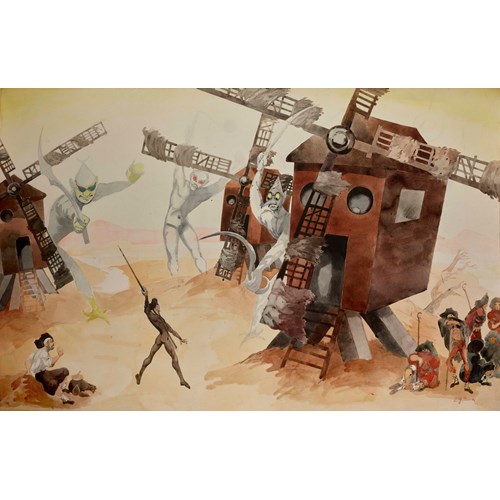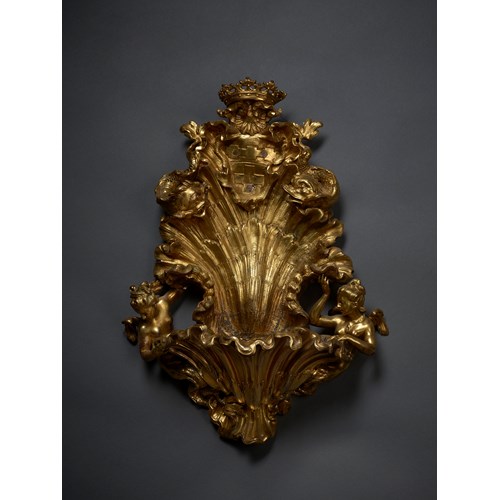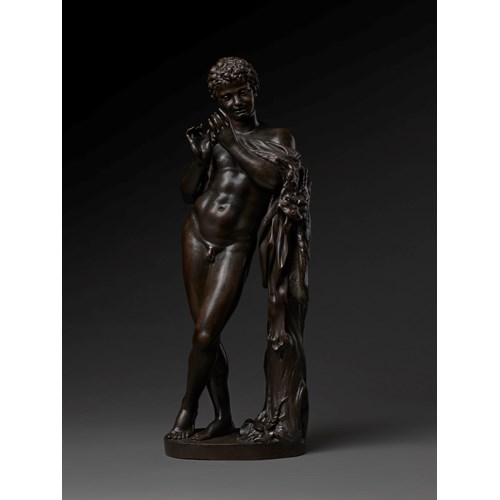Marketplace
The Genius of Peace taming the Horses of Mars
Joseph Chinard
The Genius of Peace taming the Horses of Mars
Date Circa 1791
Dimension 48 x 71 x 4 cm (18⁷/₈ x 28⁰/₁ x 1⁵/₈ inches)
The name of the great Lyonnaise sculptor Joseph Chinard is synonymous with terracotta sculpture from the French Revolutionary era. This relief includes many exquisite details that showcase his skill in this medium, such as the modelling of the naturalistic leather straps from a cuirass that hang over the ledge at the bottom-right of the scene and create an illusory sense of depth and movement.
A typical sculptural conceit visible in Chinard’s relief work, is the complex and playful relationship he establishes between parts of the modelled figure and the bounds of the relief. He often configures certain parts to protrude precariously over the edges, which creates the added illusion of depth and movement, whilst also charging the work with a tension, dynamism and a sense of trompe l’oeil. Chinard’s handling of the clay is also typically daring and full of bravura in this work. It is shown to great effect in his volumetric rendering of the Genius’ coiffure and the suppression of the hair’s density behind diadem or hairband (fig.2&3). As it is in the virtuoso, laser-like precision in the modelling of the fingers. There are also fine passages of shallow relief work that suggest the feathered wings, the raised details of the shield, the upturned torch’s smoke, and the clouds of dust kicked up by the horses. In addition to this, the striated treatment of the
surface is quintessentially Chinard, as are the rapier-like, calligraphic incisions made to the surface of the clay that are employed to define the horses’ manes and tails.
Chinard modelled this terracotta relief circa 1791, during his second trip to Rome. We can deduce this through the existence of another version which is signed and dated to this year. It belonged to Lord Bassey and was sold at Sotheby’s London on 7th July 1961, as lot 32. Differences between these two reliefs exist in the details, such as variations in the styling of the horses’ mane, differences in the shape of the shields (oval, as opposed to rectangular) and a royal crown instead of an olive wreath. The signed and dated Bassey relief is possibly the second version. The presence of structural faults in the form of firing cracks in our relief appear to have been resolved by period repairs by the artist. Chinard clearly had to contend with the problem of the sculpture cracking in the kiln, due to the exceptionally soft nature of the clay. He of course would not have had access to the technical materials we have today to adhere it together in order to safely mount it. Perhaps he had to re-model a second, more robust version and in the process, made minor adjustments to the design. This could explain why the second version has a crown added, which forms a more overt message of the taming of the royalist aristocracy, i.e. disarming them by removing their helmet and armour and bringing their horses to heel. Interestingly, at the Salon of 1767, the painter Lagrene exhibited The Aristocracy, or Bellona (the Roman goddess of war), Presenting Mars with the Reins of her Horses. Therefore, the rampant horses in Chinard’s scene could perhaps be interpreted as belonging to a ‘war mongering’ French aristocracy, especially considering that in the second version, a French royal crown replaces the laurel wreath shown surmounting the trophy of arms.
In this terracotta relief, the winged Genius of Peace restrains three savage, rearing horses, that have become separated from the chariot that belongs to Mars, the god of war. Peace deftly leaps over a trophy of discarded Roman arms and armour, an upturned torch and a laurel wreath of peace and victory. This composition, and its associated iconography, form an allegorical representation of the triumph of peace, over war. The work was created during the French Revolution (1789 – 1799), a period that was among the most turbulent in the history of France and one which precipitated a series of bloody European wars. At moments when the desire for civil and international conflict was satiated, one imagines that there was a demand for works that promoted peace. Therefore, this work could have been commissioned by, or intended for, an audience that was sympathetic to halting hostilities and civil unrest.
The political nature of Chinard’s sculpture occasionally brought him into conflict with the authorities. In 1792, just after the creation of this relief and whilst he was studying at the French Academy in Rome, Chinard was imprisoned for two months in the Castel Sant’Angelo because the Papal authorities believed two of his terracotta models of Apollo Treading Superstition Underfoot and Jupiter Treading Aristocracy Underfoot, to be politically threatening. Chinard’s wife wrote in a letter to Fran.ois-Jean-Baptiste Topino-Lebrun that she was terrified he was to be hauled in front of the Inquisition for his outspoken patriotism and public revolutionary zeal, which had angered the royalist Catholic priests in Rome. The authorities seized his sculptural models, along with his hat with the banned tricolour republican cockade of the Revolution.
After Chinard’s release from the Castel Sant’Angelo he returned to his native Lyon. However, he was rearrested by the French authorities in 1793, for producing work that was considered too politically moderate and he again spent several months in jail. After he was acquitted in 1794, Chinard began making work that served the Republique, the Directoire, the Empire, and promoted the values associated with the Revolution: liberty, equality, democracy, fraternity, a new national identity, and civic pride. For example, he was involved in creating a monumental Arc de Triomphe for Napoleon's triumphant entry into his home city of Lyon, in January 1802 (22 Niv.se year X).
Pre-revolutionary sculpture in France was rarely politically radical. However, between 1774 and 1830, France was shaken by the most important political events of its history, public consciousness was profoundly transformed and the art of this period thus became highly politicised. So, although Chinard’s relief appears to represent a benignly mythological, classical subject, the combination of the febrile postrevolutionary environment and the politicisation of art at this time, together with his firebrand personality, encourages Chinard’s sculpture to be read as possessing potent, socio-political sentiment. Indeed, Walsh claims that Chinard’s audience would have “possessed the necessary visual skills and repertoires in order to be able to decode and respond to the particular sculptural imagery proposed by the sculptor within a sharply changed social-political context.” This being so, it was Chinard’s “combination of the received tradition of allegory” and his “highly particularised formulations” of them, that made his “message clear and legible.”
This relief appears to have inspired two contemporary paintings of the same subject by the sculptor’s friend, Benigne Gagneraux (1756-1795), whom he was studying with at the Acad.mie de France in Rome. The earliest example of Gagneraux’s painting is dated 1792, a year later than Chinard’s signed and dated version of this relief.
Interestingly, a version of Gagneraux’s painting was owned by the Swiss philanthropist, the Comte Jean-Jacques de Sellon (1782 – 1839), who, as a boy of 12, had travelled with his parents to Rome, where he was greatly affected by the massacre of the French. He subsequently committed his life to humanitarian causes, founding Société de la Paix (Peace Society) in 1830.
A typical sculptural conceit visible in Chinard’s relief work, is the complex and playful relationship he establishes between parts of the modelled figure and the bounds of the relief. He often configures certain parts to protrude precariously over the edges, which creates the added illusion of depth and movement, whilst also charging the work with a tension, dynamism and a sense of trompe l’oeil. Chinard’s handling of the clay is also typically daring and full of bravura in this work. It is shown to great effect in his volumetric rendering of the Genius’ coiffure and the suppression of the hair’s density behind diadem or hairband (fig.2&3). As it is in the virtuoso, laser-like precision in the modelling of the fingers. There are also fine passages of shallow relief work that suggest the feathered wings, the raised details of the shield, the upturned torch’s smoke, and the clouds of dust kicked up by the horses. In addition to this, the striated treatment of the
surface is quintessentially Chinard, as are the rapier-like, calligraphic incisions made to the surface of the clay that are employed to define the horses’ manes and tails.
Chinard modelled this terracotta relief circa 1791, during his second trip to Rome. We can deduce this through the existence of another version which is signed and dated to this year. It belonged to Lord Bassey and was sold at Sotheby’s London on 7th July 1961, as lot 32. Differences between these two reliefs exist in the details, such as variations in the styling of the horses’ mane, differences in the shape of the shields (oval, as opposed to rectangular) and a royal crown instead of an olive wreath. The signed and dated Bassey relief is possibly the second version. The presence of structural faults in the form of firing cracks in our relief appear to have been resolved by period repairs by the artist. Chinard clearly had to contend with the problem of the sculpture cracking in the kiln, due to the exceptionally soft nature of the clay. He of course would not have had access to the technical materials we have today to adhere it together in order to safely mount it. Perhaps he had to re-model a second, more robust version and in the process, made minor adjustments to the design. This could explain why the second version has a crown added, which forms a more overt message of the taming of the royalist aristocracy, i.e. disarming them by removing their helmet and armour and bringing their horses to heel. Interestingly, at the Salon of 1767, the painter Lagrene exhibited The Aristocracy, or Bellona (the Roman goddess of war), Presenting Mars with the Reins of her Horses. Therefore, the rampant horses in Chinard’s scene could perhaps be interpreted as belonging to a ‘war mongering’ French aristocracy, especially considering that in the second version, a French royal crown replaces the laurel wreath shown surmounting the trophy of arms.
In this terracotta relief, the winged Genius of Peace restrains three savage, rearing horses, that have become separated from the chariot that belongs to Mars, the god of war. Peace deftly leaps over a trophy of discarded Roman arms and armour, an upturned torch and a laurel wreath of peace and victory. This composition, and its associated iconography, form an allegorical representation of the triumph of peace, over war. The work was created during the French Revolution (1789 – 1799), a period that was among the most turbulent in the history of France and one which precipitated a series of bloody European wars. At moments when the desire for civil and international conflict was satiated, one imagines that there was a demand for works that promoted peace. Therefore, this work could have been commissioned by, or intended for, an audience that was sympathetic to halting hostilities and civil unrest.
The political nature of Chinard’s sculpture occasionally brought him into conflict with the authorities. In 1792, just after the creation of this relief and whilst he was studying at the French Academy in Rome, Chinard was imprisoned for two months in the Castel Sant’Angelo because the Papal authorities believed two of his terracotta models of Apollo Treading Superstition Underfoot and Jupiter Treading Aristocracy Underfoot, to be politically threatening. Chinard’s wife wrote in a letter to Fran.ois-Jean-Baptiste Topino-Lebrun that she was terrified he was to be hauled in front of the Inquisition for his outspoken patriotism and public revolutionary zeal, which had angered the royalist Catholic priests in Rome. The authorities seized his sculptural models, along with his hat with the banned tricolour republican cockade of the Revolution.
After Chinard’s release from the Castel Sant’Angelo he returned to his native Lyon. However, he was rearrested by the French authorities in 1793, for producing work that was considered too politically moderate and he again spent several months in jail. After he was acquitted in 1794, Chinard began making work that served the Republique, the Directoire, the Empire, and promoted the values associated with the Revolution: liberty, equality, democracy, fraternity, a new national identity, and civic pride. For example, he was involved in creating a monumental Arc de Triomphe for Napoleon's triumphant entry into his home city of Lyon, in January 1802 (22 Niv.se year X).
Pre-revolutionary sculpture in France was rarely politically radical. However, between 1774 and 1830, France was shaken by the most important political events of its history, public consciousness was profoundly transformed and the art of this period thus became highly politicised. So, although Chinard’s relief appears to represent a benignly mythological, classical subject, the combination of the febrile postrevolutionary environment and the politicisation of art at this time, together with his firebrand personality, encourages Chinard’s sculpture to be read as possessing potent, socio-political sentiment. Indeed, Walsh claims that Chinard’s audience would have “possessed the necessary visual skills and repertoires in order to be able to decode and respond to the particular sculptural imagery proposed by the sculptor within a sharply changed social-political context.” This being so, it was Chinard’s “combination of the received tradition of allegory” and his “highly particularised formulations” of them, that made his “message clear and legible.”
This relief appears to have inspired two contemporary paintings of the same subject by the sculptor’s friend, Benigne Gagneraux (1756-1795), whom he was studying with at the Acad.mie de France in Rome. The earliest example of Gagneraux’s painting is dated 1792, a year later than Chinard’s signed and dated version of this relief.
Interestingly, a version of Gagneraux’s painting was owned by the Swiss philanthropist, the Comte Jean-Jacques de Sellon (1782 – 1839), who, as a boy of 12, had travelled with his parents to Rome, where he was greatly affected by the massacre of the French. He subsequently committed his life to humanitarian causes, founding Société de la Paix (Peace Society) in 1830.
Date: Circa 1791
Dimension: 48 x 71 x 4 cm (18⁷/₈ x 28⁰/₁ x 1⁵/₈ inches)
Provenance: Private collection, Lyon
Anonymous sale, Lyon, 7 April 1997
Private European collection, to 2023
Literature: Desvernay, F. Le Vieux Lyon à l’Exposition internationale urbaine, 1914 : description des oeuvres, objets d’art et curiosités. Paris, 1915, p. 129
Plus d'œuvres d'art de la Galerie









